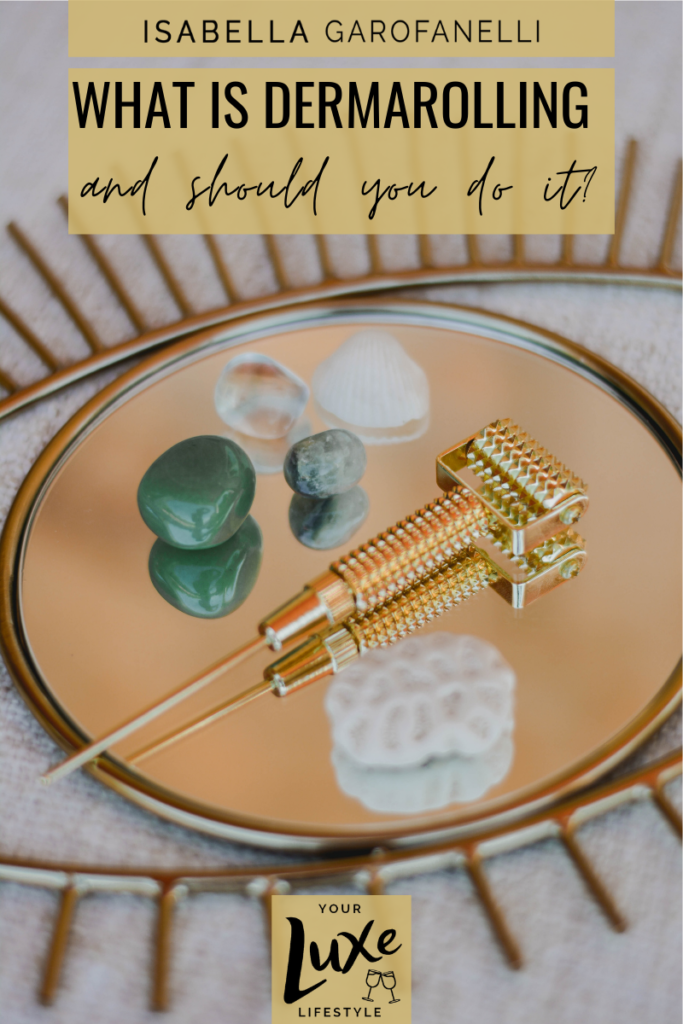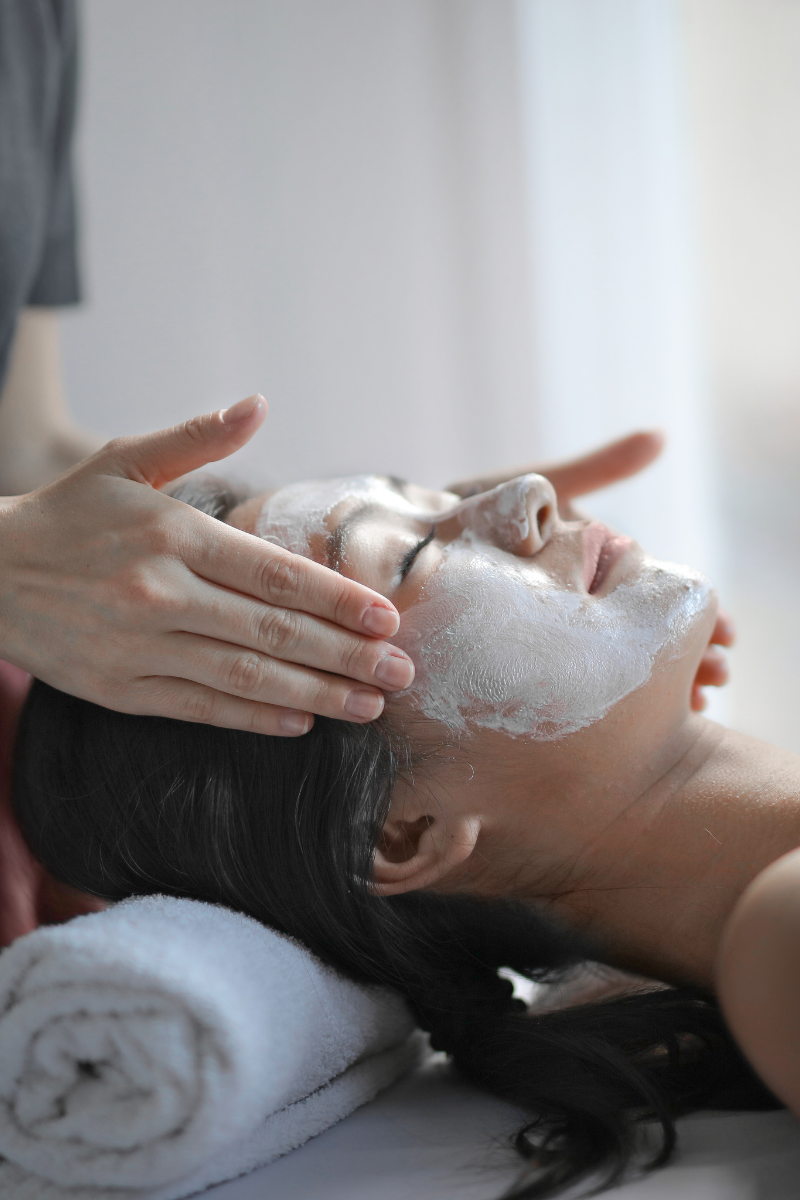Dermarolling is one of the hottest at-home beauty treatments around right now. It’s a salon-worthy procedure that’s safe, easy and affordable to perform at home – so long as you’re smart about it.
Dermarolling involves rolling a small wheel with hundreds of tiny needles across your face to make microscopic punctures in the skin. This activates the body’s healing mechanism and can really benefit the health and texture of your skin, but you should proceed with caution. As you can imagine, dermarolling may do more harm than good when performed incorrectly. Before you try dermarolling yourself, you need to know exactly how it works, what type of device to use and the proper aftercare steps to follow.


What Is Dermarolling?
Dermarolling is the same thing as microneedling. “Dermarolling” refers to the device used at home whilst “microneedling” is the process itself. It involves inserting short, fine needles into the skin for rejuvenation. The needles cause micro traumas and so provoke the skin’s healing response without actually doing any real damage. One of the biggest side-effects of the treatment is that it dramatically boosts collagen production leading to plumper, firmer skin. It also allows your serums to penetrate your skin more deeply for increased effectiveness.

The Best Dermarolling Kits for Home Use
Before we dive deeper into the benefits of dermarolling, let’s talk about what kind of dermaroller you should be using. There are lots of options out there, but you should choose a device with either titanium or stainless steel needles. Both have their benefits: titanium is more durable but stainless steel is more hygienic, although you should sterilize your roller regardless.
Secondly, you need to think about the size of the needle that you want. Personally, I feel that 0.5mm is the optimum length. 0.2-0.3mm needles are great if you just want your serums to go the extra mile, but they’re not long enough to cause the microtraumas that kick start the real benefits.
If you’re new to dermarolling or are only after the serum-boosting benefits, then I can’t recommend Sarah Chapman’s Meso Melt Infusion Roller and Pep Stem Cell Serum enough. It’s a 21 day treatment that combines microneedling with plant stem cell technology to deliver a potent skin treatment. It’s been proven to decrease wrinkle depth by up to 61%.
However, if you really want to get the most out of your microtraumas, I recommend a 0.5mm needle. This will do a great job at kickstarting skin rejuvenation but it only causes mild discomfort and so long as you’re sensible, it’s safe to use at home. It’s a happy medium between effectiveness and safety, I’d say. The following are all high quality yet affordable choices.
Salons do use longer needles of up to 1.5mm but they’re experienced professionals. Needles longer than 0.5mm will leave your face feeling pretty sore and may even require an anaesthetic cream, which I have to assume you don’t have laying around at home. The longer the needle, the more likely you are to damage your face and the longer you’ll have to worry about aftercare.

The Benefits of Dermarolling
Dermarolling is kind of like poking your skin to get a response… without actually causing any damage. It activates the healing process which stimulates collagen production and promotes cell renewal, which has a myriad of beauty benefits.
To get the most out of your treatment, be sure to apply the right serum to help with your particular skin concern, but make sure it’s gentle and hydrating. Choose a fragrance-free product to avoid irritation. Even if your skin is usually fine with fragrance, these serums are penetrating far deeper into your skin and so it’s best not to take any risks.


Improves Acne Scarring
Dermarolling encourages the skin to repair itself and create new, healthy cells so it’s a powerful way to treat acne scarring. Regular (but not too regular, remember) dermarolling can help to fade scars and improve their texture. You can see great results with an 0.5mm needle at home but if you’ve got serious scarring it might be worth going to a salon for professional treatment.
If you want to improve the appearance of acne scars, I highly recommend following up with the Olay Regenerist Daily Regenerating Serum. It’s lightweight, super affordable and it contains powerful amino-peptides to help regenerate your skin even faster. In fact, it’s great for fine lines and wrinkles, too.
It’s worth noting that dermarolling only works on acne scarring and should not be used on raised keloid scars.

Anti-Aging
Dermarolling increases cell renewal and boosts collagen and elastin production, which results in dramatically younger-looking skin. Improved rates of cell turnover smooth the skin and improve the appearance of fine lines and wrinkles over time.
Collagen, meanwhile, is a structural protein that keeps the skin firm and prevents sagging. Elastin is what enables skin to ‘bounce back’ after movement so it’s also vital in maintaining a youthful appearance. By increasing collagen and elastin production, dermarolling helps to prevent thinning skin.
To maximise the anti-aging effects of your derma rolling treatment, use the Vichy LiftActiv serum. It contains volcanic mineral water to strengthen and protect the skin, and rhamnose to further increase collagen and elastin production, and cell turnover. It’s a true powerhouse serum but it’s gentle enough that it won’t irritate your skin. Best of all, it has a very affordable price tag.

Fades Hyperpigmentation
Sun damage, acne scarring and inflammation can lead to hyperpigmentation. By provoking the body’s healing response, dermarolling can help to fade hyperpigmentation patches over time. Follow up with Skinceuticals Discoloration Defense Protective serum – they’re a science-backed skincare brand with medical-grade formulas.

Improves Rosacea
Dermarolling can help with the redness and inflammation of mild rosacea, although for serious cases it’s always best to consult a dermatologist. Follow up with La Roche Posay’s Rosaliac AR Intense Visible Redness Reducing Serum.

How Often Can I Use My Dermaroller?
The golden rule of dermarolling is “don’t overdo it.”
If you’re using a 0.1-0.3mm needle roller, you can do it every day if you wish since you’re not actually damaging your skin. However, for a 0.5mm needle, you shouldn’t do it more often than once every 2-3 weeks. Studies show that the collagen boosting results of each derma rolling treatment last between 5-7 years so there’s really no need to overdo it.
Dermarolling too often triggers the production of collagenase which is basically the anti-collagen. It’s an enzyme that breaks down the peptide bonds within collagen, so it’s the exact opposite of what you want to get out of this treatment. Less really is more.

Is Dermarolling Right For Me?
You should absolutely NOT microneedle your skin if:
1) You have active acne. Puncturing existing spots and blemishes can be very painful, cause scarring and will spread the bacteria all over your face, worsening the problem.
2) You have keloid scarring. Keloids are raised dark scars and dermarolling can actually worsen this type of scarring, so steer well clear of this treatment if you have keloid scars anywhere on your face.


Step-By-Step Guide to Dermarolling
Okay, now that you’ve got all of the information, it’s time to start dermarolling. It’s actually a pretty simple process and it doesn’t take too long.
1. Sterilize Your Roller and Wash Your Hands
Even if it’s your first time using a brand new derma roller, it’s important that you sterilize it with isopropyl alcohol before use.
2. Check For Broken Needles
Make sure that none of the needles on the wheel of your derma roller are bent or broken, as this can damage your skin.
3. Cleanse Your Face
It’s vital that you cleanse your skin properly before derma rolling as this treatment can push any residual bacteria into the skin and cause breakouts.
4. Work in Sections
When I derma roll, I mentally divide my face into four sections as this makes it easier to manage and ensure that each area receives equal attention.
5. Roll
Now, you’re ready to roll! Go across each section 4-8 times, or for one to two minutes. I tend to go up and down twice, left to right twice and then diagonally twice per section. Be gentle – there’s no need to press hard. If you start to feel any discomfort beyond a slight tenderness or tingling, it’s time to stop.
6. Avoid the Eyes
Avoid your delicate eye area and bags as the skin here is very thin and sensitive. You should definitely NOT be poking at it with needles!
7. Apply Your Serum
Once you’ve finished dermarolling, apply your chosen serum – see above for the best serums for each particular skin concern. Whatever serum you decide to go with, make sure it’s alcohol free and free from color and fragrance as these ingredients can irritate the skin.
8. Sterilise Your Roller Again
You should sterilise your roller before and after each use and store it safely.

Aftercare
Proper aftercare is very important for dermarolling. After the treatment with an 0.5mm needle, you can expect a little redness and swelling which should clear up in 24 hours. Your face may be tender for a day or two and it’s best to avoid makeup for at least 48 hours, so don’t derma roll the day before a big event! You may also experience some dryness, so make sure you’ve got a heavy duty moisturizer close at hand.
Derma rolling leaves your skin extra sensitive to the sun, so avoid direct sunlight for 72 hours if possible. This doesn’t mean you can’t go outdoors, but remember to protect your skin with a high SPF; 50+ is always best.
Avoid any harsh ingredients for the next 3-4 days. If you’re a retinoid user like me, skip your treatment for the next few nights. I’m also a die-hard vitamin C fan, but that can be irritating so I avoid it for a few days after a derma rolling treatment. Steer clear of exfoliating treatments too. Stick to nice, gentle hydrating serums like the ones I recommended earlier in this article.
Finally, don’t perform derma rolling and dermaplaning treatments too close together. Both treatments only need to be performed around once every three weeks, so be sure to space them out. They’re both incredible, but not in quick succession!

For more on skincare, check out this guide to performing an at-home facial or this list of life-changing skincare hacks!





[…] Microneedling, meanwhile, means using a dermaroller to create microtraumas and activate your body’s healing response. It’s a slightly intense form of self-care Sunday but the benefits are definitely worth it. […]
[…] What you need to know about dermarolling […]